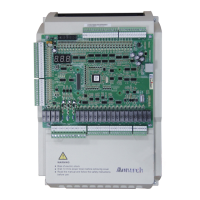- 20 -
cable and the cable connecting the controller and the motor produce leakage current, which
is much larger than the current when the motor runs at the mains frequency.
Thus, it is necessary to determine the proper RCCB sensitivity based on the general
leakage current of the cables and the motor. The leakage current is dependent on the motor
capacity, cable length, insulation class and wiring method. Generally, the leakage current
on the output side of the controller is three times of the current when the motor runs at the
mains frequency.
1.3 Protective Functions
Adopting different protective functions for different levels of faults, the NICE1000
new
provides
the elevator running system with full abnormality protection. For detailed solutions to the
faults, see chapter 8.
Faults of the controller are classied as follows:
1. Speed abnormal
The controller monitors the encoder feedback speed and output torque. Once the
feedback speed exceeds the limit or the deviation between the torque limit and the speed
feedback is too large, the controller performs protection immediately, reports an alarm
and prohibits running.
2. Drive control abnormal
The related faults include drive overcurrent, overvoltage/undervoltage, power input/
output phase loss, overload, and storage abnormality. If such a fault occurs, the controller
performs protection immediately, stops output, applies the brake and prohibits running.
3. Encoder abnormal
The related faults include encoder phase loss, direction reversing, wire-breaking, and
pulse interference. If such a fault occurs, the controller performs protection immediately to
avoid unexpected accidents. If pulse interference is large, the controller reports an alarm
immediately. If pulse interference is small, the controller performs position correction
every time it receives a leveling signal and clears the accumulative error.
4. Leveling sensor abnormal
The related faults include sensor failure or sensor stuck. The controller judges whether a
fault occurs based on the leveling signal change. If the leveling signal does not change
within the set time, the system reports an alarm.
5. Floor data abnormal
The system stores the oor information through the shaft auto-tuning. If the oor data is
abnormal, the system prompts the fault information at the rst-time running. During actual
running, the controller continuously compares position information input by DIs with the
stored oor data. If the deviation is large, the system reports an alarm.

